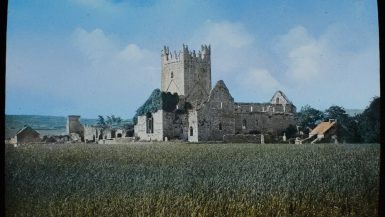ABBEYLEIX, a market and post town, a parish, and the head of a union, partly in the barony of Fassadining, county of Kilkenny, and partly in the baronies of Maryborough-West and Clarmallagh, but chiefly in that of Cullinagh, Queen’s county, and province of Leinster, 7 miles (S. S. E.) from Maryborough, and 47 1/2 miles (S.W.) from Dublin; containing 6719 inhabitants, of whom 1021 are in the town. This place, called also Clonkyne Leix, or De Lege Dei, was the site of a monastery founded about the year 600,
and refounded, and dedicated to the Blessed Virgin, in 1183, by Conogher or Coreheger O’More, who placed in it monks of the Cistercian order from Baltinglass, in the county of Wicklow, and was himself interred within its precincts. The town adjoining it. which took its name from the abbey, gradually rose to be the principal place in the territory of Leix, now Queen’s county. In the 5th of Elizabeth, the abbey and some of its possesions were granted to Thomas, Earl of Ormonde ; and the lands now form part of the estate of Viscount De Vesci. The town is situated on the mail road from Dublin, through Athy to Cashel, and contains 131 houses: the late Lord De Vesci caused the old town to be entirely rased, and laid out the present on a more eligible site. There are two woollen manufactories ; a large worsted mill and factory has been recently established near the town, for combing, weaving, and spinning yarn ; and on the river Nore, which passes in the vicinity, is a boulting-mill. The market is on Saturday; and fairs are held on Jan. 20th, March 17th, May 5th, July 20th, Sept. 20th, and Nov. 4th. The markethouse is a good building, erected by Lord De Vesci in 1836. Quarter-sessions are held in the town in June and December, and petty-sessions every Saturday; a court is also held by the seneschal of the manor ; and here is a chief constabulary police station. The sessions-house is a commodious building, and there is a small well-regulated bridewell.
The parish comprises 13,545 statute acres, of which 12,345 1/2 are in the Queen’s county : there are about
400 acres of bog, and 300 of woodland ; the soil is in general light and sandy, and the system of agriculture
is improving. Limestone of very good quality abounds, and is quarried for building, and for burning into lime; there is also a white-freestone quarry, and excellent potters’-clay is found here. Near the town is Abbey Leix, the residence of Viscount De Vesci, a spacious mansion, pleasantly situated in a demesne of about 1135 statute acres, embellished with thriving plantations and with timber of stately growth. The living is a vicarage, in the diocese of Leighlin, and in the patronage of Viscount De Vesci, who is impropriator of the rectory. The tithe rent-charge is £380. 16., of which £253.17. are payable to the impropriator, and the remainder to the vicar. The church was built in 1830, at a cost of £2215, a loan from the late Board of First Fruits ; and is a very handsome building, with a vaulted roof and an elegant
spire : the old church, close to Lord De Vesci’s mansion, is used only during summer evenings. The glebe-house was built in 1810, the Board contributing £400; the glebe comprises 5 acres. In the Roman Catholic divisions this parish is partly in the dioccese of Ossory, but chiefly in that of Leighlin; the Ossory portion being in the union or district of Ballyragget, and the other forming the head of a district, comprising also the parish of Ballyroan, and containing two chapels : that in Abbeyleix is a spacious structure, with a good school-house attached. There is a place of worship for Wesleyan Methodists. An almshouse for poor widows is maintained by Lady De Vesci ; and there are a dispensary, an infirmary, a savings’ bank, and loan and clothing funds. The workhouse for the union, occupying a site of 5 3/4acres held at a rent of £6. 12. 8., was completed in 1842, at an expense of £5850, and is constructed for 500 paupers. The tomb of Malachi O’More, with an inscription, is in the gardens of Lord De Vesci, near the site of the old abbey. At Clonking are the remains of the ancient parish church; near the town are vestiges of a Danish fort, and in the parish are several raths.
Extract from: Lewis – A Topographical Dictionary of Ireland




Leave a reply